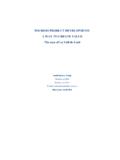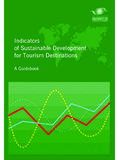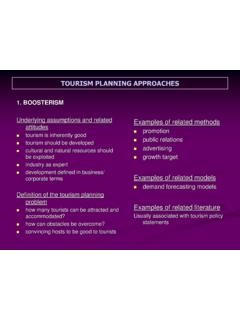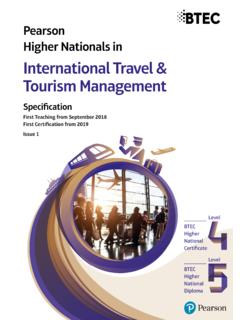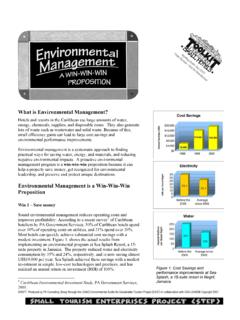Transcription of TOURISM PRODUCT DEVELOPMENT: A WAY TO CREATE …
1 TOURISM PRODUCT DEVELOPMENT: A WAY TO CREATE VALUE. The case of La Vall de Lord Jordi Datzira Masip Director of DDS. Member of AIEST. E-mail: Barcelona, April 2006. TOURISM PRODUCT Development: a way to CREATE value The case of La Vall de Lord Abstract The management of TOURISM destinations is closely related with the policies that affect local development and the creation of value in a destination. That is why a sustainable TOURISM development policy should try to obtain a balance between cultural values, environmental attractions and the economic results that the development of TOURISM can offer to a destination. Moreover, TOURISM development policy should also take into account three key issues: to establish development guidelines, to determine and control planning processes and to define the most adequate marketing strategies for the destination.
2 The creation of value in a TOURISM destination can be determined by the specialization through the creation of products targeted toward specific market segments. The creation of TOURISM products is a process that needs different elements and follows some steps. The initial step is where all basic elements are taken into account, afterwards the PRODUCT is created and finally it is communicated to the market so that it can be consumed by a part of TOURISM demand. The case of la Vall de Lord shows the most important features of the destination and how TOURISM development is being managed. The current situation is pictured through the demography, the territory, the population distributed by economic activity and the TOURISM supply and its demand. It is also established the TOURISM PRODUCT portfolio in which the Valley has specialized itself, the products and services it offers and the TOURISM development policy established by the local TOURISM Association which describes the activities that will be done throughout 2006.
3 The conclusions refer to the most relevant weaknesses in TOURISM management, improvement needs and the development possibilities which holds la Vall de Lord as a TOURISM destination. Index A. Introduction B. TOURISM development policy C. TOURISM PRODUCT creation D. The case of La Vall de Lord E. Conclusions F. Bibliography IV International Doctoral TOURISM and Leisure Colloquium. ESADE. May 2006 Jordi Datzira Masip 2. TOURISM PRODUCT Development: a way to CREATE value The case of La Vall de Lord A. Introduction 1. Which policy areas are crucial for the development of TOURISM ? 2. What can be done by a TOURISM destination to enhance its value? 3. What are destinations doing to develop their TOURISM ? B. TOURISM development policy The significance of a balanced and sustainable TOURISM development policy The WTO (2004) affirms that sustainability principles refer to the environmental, economic and socio-cultural aspects of TOURISM development, and a suitable balance must be established between these three dimensions to guarantee its long-term sustainability'.
4 On the significance of a sustainable TOURISM development policy Ritchie, B and Crouch, G (2003: 148), affirm that TOURISM policy seeks to provide high-quality visitors experience that are profitable to destination stakeholders, while ensuring that the destination is not compromised in terms of its environmental, social and cultural integrity'. And define TOURISM policy as a set of regulations, rules, guidelines, directives and development/promotion objectives and strategies that provide a framework within which the collective and individual decisions directly affecting TOURISM development and the daily activities within a destination are taken'. Following this idea, a sustainable TOURISM policy must include three basic aspects for the development of TOURISM and should find the correct balance between: Cultural values Environmental resources Economic results But it also should take into account the three key areas of a TOURISM development policy for destinations at any level, local, regional, national or international.
5 The key areas that should be present to achieve the established goals, all through the sustainable TOURISM development process of any destination, are the following: Establishment of development guidelines Determine and control the planning process Define a marketing strategy and actions IV International Doctoral TOURISM and Leisure Colloquium. ESADE. May 2006 Jordi Datzira Masip 3. TOURISM PRODUCT Development: a way to CREATE value The case of La Vall de Lord Figure 1. Key areas of a TOURISM development policy To Establish a To Determine a To Define a Objectives Development Guideline Planning Process Marketing Strategy To regulate TOURISM activity To control development To define target markets &. To CREATE and maintain limits & speed target groups good conditions: To CREATE land use To establish an added value - Infrastructures procedures strategy - Facilities To CREATE carrying To determine the - capacity criteria: destination's image &.
6 To train and specialise - Cultural positioning Actions human resources - Environmental To define marketing mix To ensure quality - Economic - PRODUCT standards To organise TOURISM sector - Communication To CREATE critical mass structure - Promotion To involve local Other - Sales community - Other Other To establish a clear To devise a focused vision of destination's To implement a long Results strategic & operational competitiveness & term strategic planning marketing plan sustainability Source: Datzira-Masip, J. 'Cultural Heritage TOURISM -Opportunities for PRODUCT development: the Barcelona case' in TOURISM Review, Vol 61, No 1 AIEST. 2006. As shown in figure 1, three key areas are defined as follows: Development guidelines should help in the adequate development of a destination and at the same time should guarantee a clear vision of a rational and balanced development with the aim of the improvement of the competitiveness and sustainability of the destination.
7 Planning process is an essential tool that provides a framework that makes such development happen, together with the introduction of control mechanisms. Successful planning results in the implementation of development strategies that ensure both long and short term sustainability and balanced growth that shall guarantee the preservation of resources of a destination. Marketing strategies are crucial for the promotion and commercialization of any destination that develops new TOURISM products that should be communicated to markets and target public. Both the establishment of specific marketing strategies and the application of the adequate marketing mix can help a destination increase the efficiency of marketing actions. IV International Doctoral TOURISM and Leisure Colloquium. ESADE. May 2006 Jordi Datzira Masip 4. TOURISM PRODUCT Development: a way to CREATE value The case of La Vall de Lord C.
8 TOURISM PRODUCT creation TOURISM PRODUCT portfolio strategy A TOURISM destination needs a good PRODUCT portfolio strategy to be able to develop TOURISM and specialise the existing supply of the destination. The portfolio should be based on the existing attractions and resources, but it should also take into account the essential infrastructures, facilities and services needed to make the development come true. During the process other criteria will be needed to help in the accurate evaluation of the real success potential of the different products. These criteria can be economic, social, cultural, environmental or political, among others. Some examples can be the market potential assigned to the PRODUCT , the image creation and positioning of a destination, the attractiveness of public or private investment, the foreseen level of investment, the expected results, the social cost-effectiveness of the demonstration effect that can mean the creation of new products.
9 Following this idea, the creation of a complementary supply can help in the definition of an adequate PRODUCT portfolio for a destination. But, always bearing in mind a clear and coherent development strategy that will try to specialise the services, to be able to be differentiated from the competition, and taking into account the needs of the different actors present through the process of development and creation of new products Creation of TOURISM products Once the PRODUCT portfolio is defined and the destination is specialized, it will be time to CREATE products and services to complement the basic TOURISM supply of accommodation and restaurants. Anyway, the creation of products follows a process that includes different elements specified in the following figure: Figure 2. Key elements in the PRODUCT creation process Initial stage Motivation to Travel Management Organisation Basis Destination's resources & attractions Infrastructures Facilities Services Creation process Activities & experiences TOURISM supply Image & Communication & Sales &.
10 Communication positioning Promotion Commercialisation Result Tourist Consumption or Exchange Source: Adapted from Datzira-Masip, J. 'Cultural Heritage TOURISM -Opportunities for PRODUCT development: the Barcelona case' in TOURISM Review, Vol 61, No 1 AIEST. 2006. IV International Doctoral TOURISM and Leisure Colloquium. ESADE. May 2006 Jordi Datzira Masip 5. TOURISM PRODUCT Development: a way to CREATE value The case of La Vall de Lord Figure 2 shows the key elements in which the TOURISM PRODUCT creation process is divided. There are 5. different areas and the result is the stimulation of tourist consumption in a destination: Initial stage: existence of a motivation to travel. Basis: resources and attractions are the basis of a destination. Creation process: it requires not only the existence or creation of infrastructures, facilities and services but also the development of specific activities or experiences.
